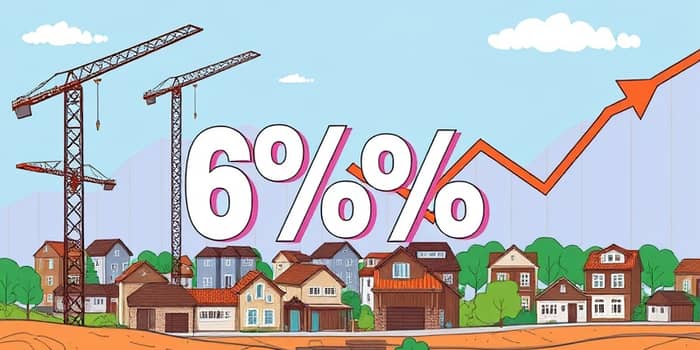
In May 2025, U.S. housing starts plunged by 9.8% month-over-month to an annualized rate of 1.26 million units, surprising analysts and underscoring the strain high borrowing costs place on new home construction. This abrupt slowdown follows a brief rebound in April, when starts edged up 1.6% to 1.361 million units after a steep decline in March.
While the multi-family segment showed pockets of strength earlier in the year, builders nationwide now face daunting challenges, from elevated mortgage rates to rising material costs. As the sector adjusts to tighter borrowing conditions, the outlook for both single-family and multi-family projects has become increasingly uncertain.
Mortgage rate hikes have reconfigured the landscape for prospective homebuyers and developers alike. The average 30-year fixed mortgage rate, although down from its peak, remains elevated by historical standards, hovering around 6.89% in early February 2025. High rates translate into larger monthly payments, eating into household budgets and dampening appetite for new homes.
Affordability metrics highlight the burden: a typical mortgage payment now consumes 33.5% of median household income, compared to a peak of 37.2% in late 2023. Even modest declines in rates offer limited relief when the cost of financing remains close to three-decade highs.
Residential building permits, a forward-looking indicator of construction intent, fell 4.7% in April to 1.41 million units, with both single-family (-5.1%) and multi-family (-3.7%) categories in retreat. The decline in permits foreshadows weaker starts in the coming months, as builders hold back in response to financing uncertainties.
The dip in housing starts has not been uniform across the country. Regional dynamics reveal sharp contrasts, driven by local economies, land availability, and sentiment.
In April, the South and Northeast saw substantial gains as developers capitalized on more favorable land costs and local incentives. By contrast, the Midwest and West experienced steep declines, reflecting higher regulatory hurdles, labor shortages, and cost pressures. May’s nationwide drop suggests those regional gains may be temporary if mortgage rates remain elevated.
One of the most persistent drags on market fluidity is the so-called lock-in effect. Approximately 83% of existing homeowners have mortgage rates below 6%, creating a powerful disincentive to sell. Low-rate borrowers remain in place, reducing turnover and constraining supply of existing homes for sale.
Existing home sales are at their lowest level since 1995, and while new listings have grown modestly, inventory remains tight relative to demand. New homes for sale have risen to 481,000 units, the highest level since 2007, yet this supply increase has barely dented affordability constraints.
Builders cannot fully offset the inventory squeeze because higher lot and material costs eat into profit margins. As a result, potential buyers face limited choices and must often stretch budgets to secure financing, reinforcing hesitancy in the market.
Construction firms grapple with a confluence of challenges. Material prices, while off their pandemic highs, remain significantly above pre-2020 levels. Land acquisition costs have soared in many metro areas, and labor shortages persist, driving wages higher.
Sentiment surveys reveal growing caution among home builders. Many forecasters have revised their housing starts projections downward for 2025, citing slowing economic growth and the specter of a mild recession. Long-term demographic headwinds—lower birth rates, an aging population, and reduced immigration—also temper expectations for robust demand.
Despite current headwinds, the housing sector retains underlying strength. Pent-up demand from younger cohorts, record household formations, and chronic underbuilding since the Great Recession provide a foundation for eventual recovery.
However, short-term forecasts are muted. Industry analysts project 2025 housing starts in the range of 1.35–1.37 million units, below the long-term average of 1.43 million. Permits and starts may remain subdued through the year unless mortgage rates ease substantially.
By 2027, housing starts could rebound to 1.47 million units if economic conditions stabilize and cost pressures ease. Yet, growth is expected to remain below 3% annually as the market absorbs demographic shifts and budget constraints.
The housing market in mid-2025 stands at a crossroads. Builders and buyers alike navigate a landscape reshaped by mortgage rate hikes and affordability challenges. While regional gains and steady demand offer glimmers of hope, the sector’s near-term trajectory hinges on the path of interest rates and policymakers’ ability to ease cost burdens.
In this pivotal environment, stakeholders must balance caution with strategic investment. For home builders, selective project launches in high-demand areas may mitigate risk. For prospective buyers, monitoring rate movements and exploring diverse financing options can unlock opportunities even in a constrained market.
Ultimately, the dip in housing starts is not just a cyclical lull but a signal of deeper transformations. The industry’s capacity to adapt—to innovate in construction methods, streamline approval processes, and offer creative financing—will determine whether the housing market emerges resilient or remains in a protracted freeze.
References













